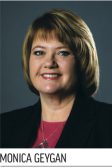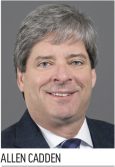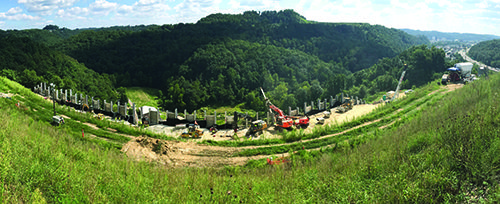Four years of passionate perseverance, determination and hard work paid off on July 19, when Yeager Airport (CRW) finished the $25 million reconstruction of its runway safety area. Completing the project was an important milestone as the West Virginia airport continues to recover after a massive airfield landside that occurred on March 12, 2015.
Four years of passionate perseverance, determination and hard work paid off on July 19, when Yeager Airport (CRW) finished the $25 million reconstruction of its runway safety area. Completing the project was an important milestone as the West Virginia airport continues to recover after a massive airfield landside that occurred on March 12, 2015.
The catastrophic failure of a mechanically stabilized earth retention structure on the 05 end of Runway 05-23 sent more than 540,000 cubic yards of fill sliding down a steep slope, across a roadway, onto a church and into a creek. No one was killed or injured in the incident; but the church was destroyed, nearby homes were damaged by subsequent flooding, and the airport’s runway safety area (RSA) and engineered material arresting system (EMAS) were destroyed.
After intense emergency response and cleanup efforts, CRW had to formulate a new engineering approach, reconstruct the RSA and deal with multiple legal issues. While many would consider the extended recovery process exhausting or overwhelming, Airport Director Terry Sayre characterizes the last four years as “trying.”
|
facts&figures Project: Rebuilding Runway Safety Area Location: Yeager Airport—near Charleston, WV Owner/Operator: Central West Virginia Regional Airport Authority Cost: $25 million Funding: 90% FAA Airport Improvement Program; state funded the 10% local match Catalyst: Collapse of runway safety area structure in March 2015 Damage: 540,000+ cubic yards of fill slid down embankment, across road & onto a church; material also spilled into a creek, causing flooding that damaged nearby homes Emergency Response & Cleanup: $11 million Runway Safety Area Study & Master Plan: Landrum & Brown Project Engineer: Schnabel Engineering Design Services: Airport Design Consultants Inc. Engineered Materials Arresting System: ESCO/Zodiac Aerospace Geofoam Expanded Polystyrene Blocks: Plasti-Fab Noteworthy Detail: Airport remained operational throughout aftermath |
Elevated Airfield
The airfield at CRW sits high on a hill, with steep slopes off the end and both sides of Runway 05. In fact, crews leveled three mountaintops and filled in the valleys between them to create the airport back in 1947.
In 2006, FAA funded a $9.2 million fill project to improve the RSA on the 05 end of CRW’s sole runway. The EMAS that was installed sat atop 1.5 million cubic yards of engineered fill. At the time, the 240-foot structure was the largest man-made fill project in North America and won multiple awards.
The RSA improvements proved invaluable in 2010, when a Bombardier CRJ-200 carrying 34 people overran the runway and stopped 128 feet inside the EMAS. “The plane skidded almost 2,000 feet on the runway before it went into the EMAS,” Sayre recalls earnestly.
Unfortunately, the structure began exhibiting signs of deterioration in summer 2013. During routine inspections, airport maintenance workers noticed that the EMAS blocks had separated. “There was an obvious crack that you could see with the naked eye,” Sayre explains. “So we monitored that, per the engineer’s recommendations.”
In March 2015, maintenance workers started seeing drastic settlement—as much as 6 or 8 feet overnight. “The fill project was slowly collapsing, and the rain and freeze/thaw that were going on in March just made a bad situation worse,” Sayre laments. “We knew it was going to go; we just didn’t know when.”
In preparation for a possible disaster, CRW began reviewing its emergency management plan. The day before and again just two hours before the 2015 collapse, airport staff and local emergency responders performed tabletop emergency exercises to project what would happen if a collapse occurred. “We anticipated the creek would be dammed up and we would need to evacuate the neighborhood to keep everyone safe,” relates Assistant Airport Director Nick Keller. “Preplanning was really key. We basically laid out the scenario, so everybody had time to think about it, and talk over what we would do.”

Thanks to those discussions and exercises, personnel were more prepared to respond when the collapse occurred, Keller reflects.
For instance, local 911 services sent automated phone messages that had been crafted in advance to inform airport neighbors about the collapse and urge them to evacuate. Fire and police department personnel also went door-to-door spreading the word.
Per CRW’s emergency response strategy, 139 people were evacuated from nearby homes. Displaced residents were accommodated in local hotels and given a per diem from the airport. “We tried to take care of the neighborhood the best we could,” Sayre says. Police patrolled the area around-the-clock to protect evacuated homes.

Fearing another slide, the airport remained in emergency management mode. “Every time it rained, we had to make sure the rest of the material didn’t collapse,” Sayre relates. Sadly, another collapse occurred that summer, and 10,000 to 20,000 more cubic yards of dirt tumbled down the embankment. “Then, the rest of it was standing up there like a big cliff, ready to fall about any moment,” he recalls.
Inclement weather only added insult to injury. “Unfortunately for us, during the second event, it just kept raining,” relates Sayre. Fill material eventually dammed the creek, and several nearby homes were flooded. “There was a lot of property damaged,” he remarks somberly.
During the lengthy aftermath, CRW spent approximately $11 million out of pocket on emergency response, which included purchasing about a dozen flooded homes. The airport took loans against its parking and rental car garages to meet the financial obligation, and its insurance carrier settled with the church and other property owners. The airport netted about $8 million (after attorney fees and case-related expenses) when legal settlements were reached earlier this year with the companies involved in the design and construction of the original man-made fill project.

Moving forward, the airport hired Landrum & Brown to conduct an airfield master plan. Discussions with the FAA and airport prompted the team to begin with an RSA study to improve safety and restore as much of the runway length as possible, explains Monica Geygan, an associate vice president with the consulting firm. FAA funded the study.

Recovery Process
Solutions to rebuild were limited due to the local landscape and the runway’s proximity to a nearby county road. “We knew we didn’t want to go back with a man-made fill project after watching one just fall over the hill,” Sayre remarks.
One thing was certain: The plan had to include an EMAS that fit the airport’s aircraft mix, which includes a combination of CRJ-200s, CRJ-700s, Embraer 145s, 737-700s and A319s.
Shortly after the initial landslide, CRW retained Schnabel Engineering to manage the deconstruction of the remaining structure and develop alternatives for the rebuild. Using a risk management approach, the company helped stakeholders outline potential risk factors, and then used that list as a guide for evaluating alternative ways of deconstructing the slope.
Ultimately, engineers decided to reduce the load on top of the slope so contractors could stabilize it as they worked their way down. “We couldn’t start from the bottom and work our way up because it would have destabilized the slope and caused more movement,” explains Allen Cadden, a principal with Schnabel.
Cleaning up debris from the collapse took roughly two years and cost about $5 million. Crews moved approximately 540,000 cubic yards of material into a barrow area on property adjacent to the damaged end of the runway CRW purchased after the collapse. Crews separated out the debris, and some of the earth material was used during reconstruction.
About eight alternatives were considered for rebuilding the RSA and runway. Many included plans to completely fill in the valley, which would have required considerable earthwork and reduced the length of the runway. Working with the EMAS manufacturer (Zodiak), engineers determined that the new aircraft overrun bed could be smaller than the previous one and still provide the same level of safety. “That allowed us to start looking at a shorter length, and it happened to align well with where the rock was encountered in the deconstruction,” Cadden states.

The project team used a risk assessment matrix to evaluate the eight alternatives. After balancing the risks identified during deconstruction with long-term operational issues, engineers calculated the probability and associated consequences of each risk and applied a weighting factor of importance. “We didn’t take that as an absolute number,” says Cadden. “But it allowed us to compare the eight options and eliminate some that really looked high risk and low value. Then, we could dive a little deeper into the two or three that were most appealing.”
The solution that emerged includes an 85-foot concrete wall anchored with steel bars into the rock. The wall supports one corner of the fill project and provided room for the new EMAS bed. Cadden notes that the remaining fill was put back on a 2-to-1 slope gradient, making it more stable than the original build.
Typically, retaining walls backfilled with soil have very high pressure on them; so constructing a retaining wall of this size with the strength to resist such pressure would have been both a “significant and expensive endeavor,” Cadden explains.
To address this issue, the lower 25 feet of the retaining wall was backfilled with soil; and 60-foot piles for the wall are anchored 35 feet into the ground, with two rows of tiebacks into the rock. The upper 55 feet of the wall is backfilled with lightweight molded geofoam blocks, manufactured by Plasti-Fab. On top of the 6,000+ expanded polystyrene blocks is roughly 3 feet of soil, which provides a cap over the geofoam to spread out the weight load from aircraft. A membrane was added between the geofoam and soil fill to protect the foam from damaging contaminants such as jet fuel.
An instrumentation system attached to the piles monitors deflections on the face of the wall in half-meter increments. Another monitoring system tracks compression of the backfill soil.
Sayre notes that the new structure also includes drainage to remove the rain that West Virginia often receives. “If you don’t have the proper drainage and control the water, it’s hard to keep what you have stable,” he explains.
Engineers added a drainage system behind the wall at the base and up the existing slope to manage seepage during construction. “There was a lot of effort to make sure we had redundant systems to get water out from behind the wall,” Cadden notes.
Another critical step in moving forward was ensuring that stakeholders were comfortable with the engineering solution. To help instill confidence, the airport hired an independent third-party engineering firm to perform a peer review of the proposed fix, and an expert in geofoam technology from the University of Memphis also weighed in. Both provided assurance about CRW’s plan.
During reconstruction, access for crews proved to be a challenge. Working at the end of the runway, on a slope, the team had a narrow bench to install piles and drill in the anchors. “It was basically one operation at a time,” says Cadden. “You could put the piles in, then you could put the anchors in; but you really couldn’t do two or three things at one time.”
Legislative Intervention
In addition to overcoming geography challenges, the airport had to come up with a plan to pay for the recovery and replace the RSA. “FAA said they’d like to help us,” Keller relates. “Unfortunately, a rebuild would not be eligible [for federal funding].”
Airport officials consequently turned to local stakeholders and their congressional delegation. Working tirelessly, the coalition managed to amend U.S. code by adding a provision for RSA repair. “Once that became law, it made the project eligible for FAA funding,” he adds.
Geygan and other Landrum & Brown executives credit the “level-headed persistence” of the airport and its stakeholders for ensuring that the project could be completed.
 Michelle Gallo, the company’s project manager, agrees: “They are fully committed to making sure the airport is safe and providing the air service the region needs.”
Michelle Gallo, the company’s project manager, agrees: “They are fully committed to making sure the airport is safe and providing the air service the region needs.”
CRW has about 500,000 total passengers and 33,000 operations annually.
“Emergency management is key, but you have to be able to plan and have to be persistent,” Keller reflects. “We couldn’t give up. We had to have a rebuild. The FAA wanted to help, but they didn’t have a mechanism to; so we had to get our congressional delegation to help.”
Operational Impact
Through all of this, CRW never shut down. That said, flight operations dramatically declined when the airport displaced its runway threshold 577 feet to allow room for machinery to work outside the safety area during clean up and reconstruction.
Carriers accepted weight penalties on many flights; but some were cancelled. For instance, American Airlines permanently discontinued its service to Dallas Fort Worth International because weight penalties made it inefficient to fly CRJ-200s out of CRW.
“Some carriers refused to come in here because our declared distances changed and our landing distance went down to 5,724 feet,” Keller explains. “That hurt us quite a bit.”
Another complication: The airport had to turn off its navigational aids for Runway 05 during reconstruction because they were aligned with the previous threshold. “That cost us a lot of operational problems and issues with the airlines,” he adds.

Overall, Runway 05-23 lost about 75 feet of length; but the project returned almost 500 feet of runway to operation on the 05 end. “We’re back to as normal as we can be now,” Sayre reports. The instrument landing system is operating for Runway 05, and CRW has a reimbursable agreement with the FAA for a new precision approach path indicator that is scheduled to be operational this fall. “We’re in a lot better shape than we were,” he says optimistically.
Runway 05-23 is once again long enough for most current operations at CRW, Landrum & Brown is currently working on a second RSA study that addresses a fully standard RSA and
runway length to support even more operations. The firm is also working on a 20-year master plan that will address future airfield needs.



